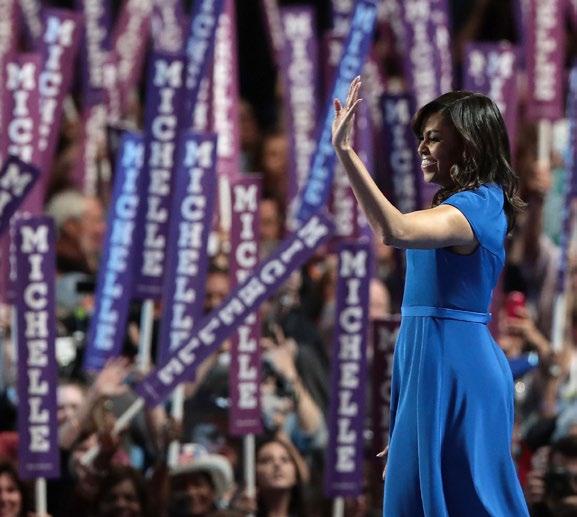
9 minute read
Isn’t it Time America Really Paid Back its Debts for Slavery?
RUNNER-UP GAINSBOROUGH PRIZE
ISN’T IT TIME AMERICA REALLY PAID BACK ITS DEBTS FOR SLAVERY?
Advertisement
By Keval Shah
The racial wealth gap
Since the end of the Civil War, America has slowly and painfully worked to break down racial barriers and heal the wounds of slavery. This is no better highlighted than the first African American First Lady’s speech at the 2016 Democratic National Convention. Michelle Obama said:


It’s now 2020. 12 years ago, America elected its first African-American President, Barack Hussein Obama. Congress is more racially and ethnically diverse than ever – 12% of the US House of Representatives and Senate are black, roughly proportional to the national population. The United States of America is truly living in a post-racial era, right? Well, not exactly…
In 1984, African-American families possessed just $4,000 in wealth on average. Wealth is the total financial value of all a family owns from savings and assets, minus any debts including home mortgages, credit card debts, and student loans. In America today, the wealth of African-American families increased to just only slightly more than $17,600. Contrary to this, average White families hold 10 times the wealth of average Black families. They have amassed a net median wealth of $171,000, increasing from $88,000 over the same period since 1984. This means the racial wealth gap between White and Black families has increased threefold over 36 years. The median Black adult who attended college has 7.2 times less wealth than the median White adult who attended college.
The Black unemployment rate is typically about twice as high as the White unemployment rate. In 2010, after the Great Recession had officially ended, the average annual unemployment rate for black workers was 16.0 percent, compared to 12.5 and 8.7 percent for Hispanics and whites, respectively. Despite the abolition of slavery and the longest of journeys in the pursuit of racial justice, the racial wealth gap persist.
Slavery
The American Dream is rooted in the Declaration of Independence. It proclaims that ‘all men are created equal’ with the right to ‘life, liberty and the pursuit of happiness.’ Americans can attain their own version of success in a society where upward mobility is possible for everyone. Given these inequities faced by Black Americans, does this American Dream hold for all Americans today?
In understanding this, we have to go 150 years back. In the 1850s and 1860s, slaves were regularly illustrated on Confederate paper currency notes in Southern states, as shown below. Much of this Confederate currency was specifically designed to, not only celebrate its White heroes, but to further validate a system which held its black labourers in perpetual slavery.
One $5 note depicted one black slave joyfully picking cotton, opposite whom, under the supervision of a white manager, other slaves worked hard in milling raw cotton. The clever way in which classical icons were juxtaposed with idyllic scenes of enslavement exemplified that the government based its economy crucially on the work of slaves and that history and tradition validated these systems. Note after note suggests a preoccupation with reminding those, from debtors, investors, as well as note-holding ordinary citizens alike, that slavery, one of the most important elements of the Southern economy, would continue to indefinitely exist, protected by the law and legitimatised by tradition.
American Slaves in the 1800s did not just epitomise America’s wealth, they were America’s wealth. In 1860, over $3 billion was the value assigned to the physical bodies of enslaved Black Americans to be used as free labour and production, much more money than was invested in railroads and factories combined. Most importantly, white families were able to keep this wealth, invest it, and pass it down to their child to do the same.
Housing discrimination
One of the key driving forces underlying the setbacks faced by African Americans is land and housing. Home equities provide the largest source of wealth for roughly three-quarters of families. Following the Great Depression, which began in 1929 and did not abate until the end of the 1930s. By 1933, unemployment was at 25 percent and more than 5,000 banks had gone out of business.
In response, the Federal Housing Administration (FHA), created in part by the National Housing Act of 1934 as part of the New Deal, was introduced by President Franklin D. Roosevelt. Their aim was to provide adequate home financing system through insurance of mortgage loans, and to stabilize the mortgage market, release mortgage credit across the American population.
The American Dream became synonymous with possessing land and owning a home. However, the FHA faced criticisms for practicing housing policies which would not ensure mortgages in ‘risky’ locations. This was largely predicted by highlighting racial demographics in different areas and red-lining disproportionately occurred at the expense of Black communities. This federally enforced segregation impacted on all aspects of the lives of Black communities; the types of jobs accessible to Black people were limited, the type of schooling, quality of education and crucially, the rate at which the value of house prices increased.
Jim Crow, the racial caste system which operated primarily, but not exclusively in southern and border states, existed between 1877 and the mid-1960s. Under which, a series of rigid anti-black laws were introduced and represented the legitimization of anti-black racism, relegating African Americans to the status of second-class citizens. 100 years of housing discrimination since slavery resulted in an enormous home-ownership gap. It was only in 1968 in which these housing discrimination laws were made illegal by President Lyndon B. Johnson. But even then, the discrimination persisted.
Subprime loans
In the 1990s, President Bill J. Clinton attempted to open up the mortgage market to ‘help families who had historically been excluded from home ownership.’ Black families were eager to obtain the regular loans, which were typically given to white families since the Great Depression from the 1930s to 1980s. Instead, African-Americans were twice as likely to get subprime loans, which was very costly for low credit borrowers.
Banks like Wells Fargo specifically targeted Black communities with exclusively subprime mortgages. Ministers of Black churches, unaware of this, received donations every time a parishioner received a mortgage and thought these mortgages would help parishioners, actively encouraging them. As a result of this, even 20% of Black borrowers with good credit receive subprime loans.
Then the 2008 financial crisis hit, taking an extremely hard hit of 53% on the median net worth of Black households, relative to White households of only 16%. Those same Black communities, who were largely targeted by Banks, bared the brunt of America’s worst recession since the Great Depression. Unlike the Great Depression, however, the $440 billion Troubled Asset Relief Program was mostly not received by homeowners. The racial wealth gap has persisted and has continued to expand since.
Reparations for slave descendants
The United States government has never compensated the descendants of slaves for their labour and the wealth they produced for white families during the slave era. Nor have they atoned for the lost equity from anti-black housing policies.
Only a radical redistribution of wealth would be able to deal with this unprecedented racial wealth gap; something like reparations. Reparations are nothing new to America. Japanese Americans received $1.5 billion to those interned during World War Two, whilst the Marshall Plan supported and provided reparations for Jewish people for the Holocaust. Reparations would firstly involve individual payments to the descendants of enslaved Black Americans, to account for both lost wages and the inability to accumulate wealth over decades.
Remission of tuition fees for descendants of enslaved Black Americans would support Black Americans to afford higher education, reducing racial disparities in education and social networking. Student loan forgiveness removes significant barriers in creating wealth and reduces the likelihood of receiving subprime loans with higher interest rates.
Gentrification is the process in which households are forced from their homes due to rising rents and higher taxes; typically forcing African Americans out of the neighbourhoods they helped to build. Housing revitalisation grants for specifically Black communities that have been neglected due to a lack of government and corporate investment.
Black neighbourhoods disproportionately need infrastructure and business, but Black business owners are less likely to obtain capital. Business grants for start-ups and expansions, to hire more workers and reduce Black unemployment, would help to remove barriers to economic and social mobility, as well as wealth building.
Conclusion
The US government is responsible for decades of racist policies which have discriminated against the slaves, and their descendants. These policies provided the opportunity for white households to accumulate wealth and expand this wealth over decades, whist black households were not given the same opportunities. These created and exacerbated an unprecedented racial wealth gap in America. In order to finally address this, America requires a radical redistribution of wealth in order to close this gap, and really pay back its debts for slavery.
References
M. L. Oliver and T. M. Shapiro. Disrupting the racial wealth gap. Contexts, 2019. Accessed 6th February 2020. https://contexts.org/articles/disrupting-the-racialwealth-gap/.
R. Nunn, J. Parsons and J. Shambaugh. Race and underemployment in the US labor market. Brookings, 2019. Accessed 6th February 2020. https://www. brookings.edu/blog/up-front/2019/08/01/race-and-underemployment-in-the-u-slabor-market/.
R. Ray and A. Perry. Why we need reparations for Black Americans. Policy 2020 Brookings: Big Ideas. Accessed 8th February 2020. https://www.brookings.edu/ wp-content/uploads/2020/04/BigIdeas_Ray_Perry_Reparations.pdf
L. Schapitl. The racial wealth gap is where yesterday’s injustice becomes today’s inequality. And it’s growing. Vox, 2019. Accessed 1st February 2020. https://www. vox.com/2018/5/23/17377084/racial-wealth-gap-explained-netflix K. Bialik. For the fifth time in a row, the new Congress is the most racially and ethnically diverse ever. Factank, 2019. Accessed 1st February 2020. https:// www.pewresearch.org/fact-tank/2019/02/08/for-the-fifth-time-in-a-row-the-newcongress-is-the-most-racially-and-ethnically-diverse-ever/
J. d’Hemecourt. Beyond Face Value: Slavery Iconography in Confederate Currency. Exhibitions. Accessed 11th February 2020. http://exhibitions.blogs.lib.lsu. edu/?page_id=707
G. Samuels. Michelle Obama’s DNC 2016 speech: Read the transcript in full. Independent, 2016. Accessed 11th February 2020. https://www.independent. co.uk/news/world/americas/michelle-obama-speech-in-full-dnc-2016-barackhillary-clinton-democratic-party-us-election-a7156031.html
BlackPast. President-Elect Barack Obama’s Election Night Victory Speech. 2008. Accessed 11th February 2020. https://www.blackpast.org/african-americanhistory/barack-obamas-presidential-acceptance-speech-nov-4th-2008/ .












